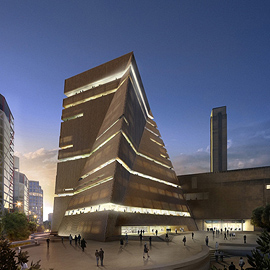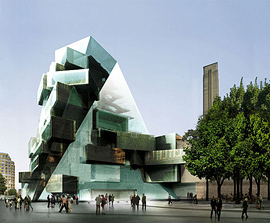
Herzog & de Meuron presented a new version of the design for the Tate Modern extension
 |
The original design, consisting of stacked blocks intersecting a glass volume, was redesigned after many consultations with artists and curators into a more compact form. Instead of the original glass facade, the connection to the existing museum building is now more emphasized through the use of bricks; however, as is customary with the work of Herzog & de Meuron, the bricks on the facade are used in an unconventional way, allowing the facade to glow at night. The architects originally considered using a raw concrete facade, which however, according to officials, would be seen as "too ugly" by the British public. A fundamental change is the creation of exhibition spaces from underground oil storage tanks, where a lecture room was to be according to the original design. The former storage spaces will be directly connected to the turbine hall, the central space of the existing Tate Modern.
 |
| Original design for the Tate Modern extension |
The current New Tate Gallery is located in a former power station designed by Sir Giles Gilbert Scott. It was out of operation from 1981 and was reconstructed as a modern art gallery according to the design by Herzog & de Meuron between 1995-2000.
> New Tate Gallery
> History of the London Tate: from sugar to a cathedral of modern art
The English translation is powered by AI tool. Switch to Czech to view the original text source.
3 comments
add comment
Subject
Author
Date
...
pipe
21.07.08 01:41
pár lepších obrázků
keyman
21.07.08 02:12
souhla
Vích
21.07.08 02:27
show all comments
Related articles
0
06.07.2016 | The expanded Tate Modern gallery attracts crowds not only for its exhibitions
0
15.06.2016 | The Tate Modern Gallery significantly expands its exhibition space
0
14.10.2015 | Tate Modern will open the extension by HdeM in June 2016
0
19.07.2012 | Tate Modern opened exhibition spaces in the former tanks
0
08.09.2011 | Tate Modern will open spaces in former oil tank facilities
3
07.11.2010 | Sunflower seeds in the London gallery Tate Modern by Ai Wei Wei
0
15.02.2010 | Helsinki Waterfront Hotel from Herzog & de Meuron












